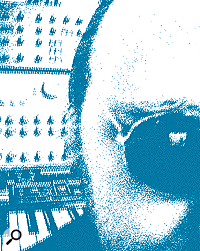It's 1975. Capes, long hair, and 45‑minute concept albums abound. (Luckily for everyone, 45 minutes is about all that can be squeezed onto two sides of a crackly, rotating vinyl frisbee.) The standard music rig of the day is a Minimoog, a Rhodes piano, a Hammond organ, maybe a Mellotron or two, and perhaps a Moog modular for the elite few tax exiles who can afford one.
Fast forward to 2001. Sports clothes, sideburns, piercings and 160‑minute double‑CD dance compilations abound. The standard music rig of the day is a couple of turntables, some boxes full of crackly, rotating vinyl frisbees, and a club PA powerful enough to do intestinal massage. The people who actually create music, as opposed to mixing it up, have retreated out of sight to back bedrooms and project studios. Armed with computers that would put an '80s‑vintage Cray to shame, and more software than anyone can ever keep track of, they barely use hardware at all any more. And just what noises can this software bonanza make? Some very fine reproductions of the Minimoog, the Rhodes piano, the Mellotron, the Hammond, the Moog modular...
I'm sure I can't be the only one who feels there's something wrong with this picture. Is this the best we can expect after 30 years of white‑hot technological advances? Looking back, it's obvious that as soon as the first Moog systems appeared, the music technology industry immediately started looking for ways to improve on the original inspiration. In short order, we had more stable tuning, sequencer control, more polyphony, and computer patching. Soon after came digital technologies such as FM, sampling, and physical modelling. And then various spin‑off technologies — including vector synthesis, S+S (Sample + Synthesis), and Kawai's partial synthesis.
But then dance music happened, everyone wanted that analogue sound again, and all further progress stalled. Synthville split into three ghettos: digitally‑modelled analogue, Sample + Synthesis workstations and sequencing toys, and soft synths. From a programmer and sound designer's point of view, all of these are pure retro, with no really new developments for at least five years now.
Don't get me wrong — I'm not complaining that I can download a free vocoder plug‑in from the Net, when 25 years ago I might have had to pay £20,000 for a big box, complete with obligatory wooden end‑cheeks, to do the same job. But still, all that anyone is ever going to get from these technologies are sounds and effects that have been heard thousands of times before.
We, as music consumers and music producers, have only ourselves to blame. While the music business has to take some of the rap, its failings aren't the whole story. The problem is us — the fact that when we're supposed to be creative, we'd rather spend our time and money on the safe, familiar and backward‑looking.
In the '70s, a classic album such as Tangerine Dream's Phaedra could sell into six figures. Today, music with the same sense of risk would be released on an obscure label no one has ever heard of, and might sell a few thousand copies. Meanwhile, back at the patchbay, exponents of traditional electronica are still in the 'floaty chord and sequencer' space TD were pioneering 30 years ago. Too much dance is just second‑rate sequencer work, glammed up with the loop of the week and some entirely predictable filter sweeps, and rock is living up to its name by evolving at truly geological timescales.
Is there hope? Surprisingly, yes. There's an array of frighteningly powerful music‑making software tools out there, but because they're considered 'hard' they don't get the same publicity as the latest toys available at your local music shop. Names like Csound, Max/MSP and PD may mean nothing to you, but these and other packages have been delighting and terrorising audiences the world over. Some of them will cost you no more than a short download and a lot of head‑scratching. If you run them on a laptop, you can even carry them under your arm and use them live. And unlike hardware synthesizers, they're getting better all the time.
True, they don't deliver instant gratification. Like real instruments, they can be seriously frustrating and hard to master. So if you want to play safe, run up a few sequences, add a loop or two, sweep a filter live, and do what everyone else is doing, these tools are not for you. On the other hand, if you want to shred sounds into oblivion, morph them, bend them, twist them till they scream, and make music that literally no-one has ever heard before, it might be time to start wondering if perhaps there's a world out there beyond the safe and familiar.
About The Author
Richard Leon writes words and music, both of which he sometimes gets paid for. His favourite synthesizer is a Pocket Piano which he bought for a fiver from the Early Learning Centre.

